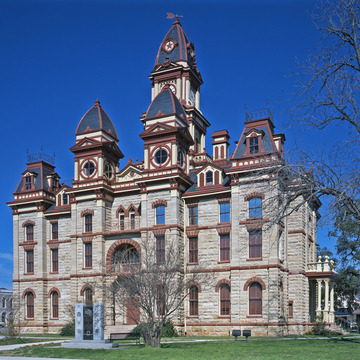The centerpiece of the county is the stately Second Empire courthouse with its dramatic mansard-roofed center and corner towers. The limestone building is a near match to the Goliad County Courthouse ( GB1) and with it part of an attribution puzzle to authorship. Guidon was a sometime partner of Alfred Giles, who claimed both of these courthouses in his promotional literature. Contractors Martin, Byrnes and Johnston were energetic builders of dozens of courthouses who often used plans and details from their many projects to complete other work without architects, as, for example, the Medina County Courthouse ( CJ13) . In an interval when he did not work for Giles, Guidon may have prepared a set of drawings that the contractors used for several projects.
The courthouse square contains some of the best late-nineteenth-and early-twentieth-century commercial buildings in the state, with their brick and limestone facades largely intact. The oldest building is the McMahan Masonic Lodge (1873; 118 S. Commerce Street) by contractor John Staffers. The first floor was occupied by a grain dealer and the second floor was used for the Masonic lodge. Also of note is Emanuel Episcopal Church (1856; 18 N. Church Street) , a small, one-story masonry structure with Gothic trim. The walls are a type of concrete construction using rock, caliche, sand, and gravel.














